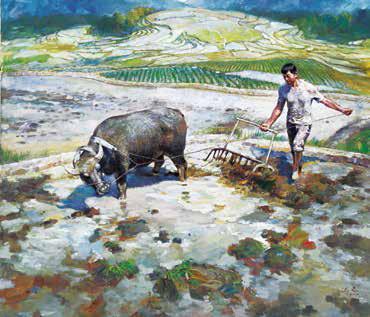Artist Focuses on Beautyof Jiangnan
Zhou Yi
Zhou Ruiwen (born in 1945), an oil painter in his 70s, thinks he is the only artist in Zhejiang who actually herded buffalos when a boy. He is proud enough to often mention this part of his childhood years to people, as testified by the two paintings in his studio: a boy rides on the back of a buffalo, sporting a bamboo hat and meandering against a backdrop of rural beauty.
Another precious memory of his boyhood years is his art teacher Zhou Jinfu. After his failure to get into an academy of fine arts, the young teacher dedicated himself to spotting and cultivating younger talents. He found Zhou Ruiwen in the youngsters junior high school years.
In 1961, the 16-year-old Zhou Ruiwen passed the entrance examination with flying colors for the affiliated middle school of Zhejiang Academy of Fine Arts. He worked hard through the next four years. He hungrily read almost all the books available in the school library. He matriculated at the oil painting department of the academy after his graduation from the affiliated middle school.
In 1967, Zhou Ruiwen made his national fame by creating an oil painting of Mao Zedong in partnership with Zheng Shengtian and Xu Junxuan, two of his art teachers at the academy. The painting was an eye-catching work of art at a national art exhibition in 1968. In the spring of 1969, the painting was mounted on a huge signboard outside the Guangzhou Trade Fair. More than ten million copies of this artwork were distributed as posters. It was also reproduced on household utensils.

《西溪風情》。West Creek, an oil painting by Zhou Ruiwen

《春耕》。Plowing in Springtime, an oil painting by Zhou Ruiwen
However, Zhous focus is not in portraits and political works. The rural life and beauty appear again and again in his artworks.
In September 1978, he began to work as an artist for Zhejiang Daily, thus starting a nearly 40-year career at the media. As an artist, he witnessed the birth and exponential growth of two well-known prints: Qianjiang Evening News, a daily newsprint, and Art News, a weekly, all published by Zhejiang Daily Press Group.
As soon as Qianjiang Evening News began circulating in 1987, Zhous cartoons appeared daily on the first page of the newsprint. Moreover, he started Art Corridor in the newspaper, a space designated to introduce artworks of old-generation artists and calligraphers to the public. On the other hand, the space displayed masterpieces for international masters. With Zhou in charge of the art office, the newspaper began to serialize , a comic strip in a four-panel format. The popular comic strip lasted until 2000. During the 12 years, more than 1,800 strips were created and published in the newspaper. It is still Chinas longest-run comic strip.
In the early 1990s, Zhou Ruiwen began to work as a photographer. The photos taken by him and his colleagues at the newspaper provide a database for sweeping changes that have transformed China. These photos are footnotes to a bygone time.
In 1993, Art News came into being. Zhou Ruiwen was one among the first people working for the new weekly. The startup had a hard time at first. The three-room office was in a single-story house which didnt see sunshine all the year round. Rats could be seen now and then. One morning, the head of the business department pulled open a drawer out of his desk and a snake came out.
The weekly soon flourished and made its national fame. Its comprehensive coverage of the First China Art Expo in 1993 established it as a national authority on art news. Thanks to Zhous initiative and coordination, some national masters jointly created a huge-size painting. A report on the giant sculpture by the West Lake touched off a heated discussion on the role art played in urban development. Wu Guanzhong (1919-2010), an artist of national renown, published a controversial essay in a magazine in Hong Kong in 1992, arguing that brushwork and ink techniques were equal to nothing, which gave rise to a nationwide debate that raged for several years in the art circles. Art News covered the debate intensely. In 1995, Art News held an art competition for children of China and Asia-Pacific Region, drawing over 20,000 students who contributed more than 30,000 pieces. The competition made waves and was considered a brilliant example of promoting art across borders.
Though heavily engaged in journalism, Zhou didnt stop painting. Since the 1990s, his artworks have been exhibited in the United States, France, Japan, Germany, Portugal, Spain and Malaysia. At an exhibition in an art gallery in Tokyo, Japan, the organizers were surprised to find that many among the buyers of Zhous artworks were artists. In Japan, artists rarely go out to buy other artists creations.
Since his retirement from journalism in 2005 at the age of 60, Zhou has dedicated to painting and to social activities. He was instrumental in setting up Zhejiang Association for International Art Exchanges and Zhejiang Academy of Contemporary Oil Painting.

